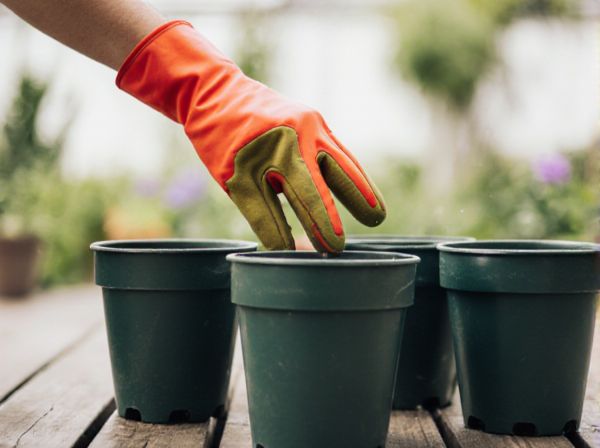
Plastic pots vs ceramic pots Illustration
Plastic pots offer lightweight durability and retain moisture longer, making them ideal for plants requiring consistent hydration. Ceramic pots provide better breathability for roots and enhance aesthetic appeal but tend to be heavier and more fragile. Choosing between plastic and ceramic pots depends on plant needs, environmental conditions, and personal preference for style and maintenance.
Table of Comparison
| Feature | Plastic Pots | Ceramic Pots |
|---|---|---|
| Weight | Lightweight, easy to move | Heavy, stable but less portable |
| Durability | Resistant to breakage, flexible | Fragile, can crack or chip |
| Porosity | Non-porous, retains moisture | Porous, allows soil aeration |
| Cost | Affordable, budget-friendly | More expensive, premium look |
| Appearance | Often plain, multiple colors | Elegant, natural finish |
| Environmental Impact | Non-biodegradable, recyclable | Natural materials, eco-friendly |
| Insulation | Poor thermal insulation | Good insulation, protects roots |
| Use | Indoor & outdoor, versatile | Best for indoor or sheltered outdoor |
Durability Comparison: Plastic vs Ceramic Pots
Plastic pots offer high durability due to their resistance to cracking, chipping, and impact damage, making them ideal for outdoor use and frequent handling. Ceramic pots, though aesthetically pleasing, are more prone to breakage when exposed to drops, frost, or sudden temperature changes. The lightweight nature of plastic pots also reduces the risk of damage during transportation compared to the heavier, fragile ceramic alternatives.
Weight and Portability: Which is Easier to Move?
Plastic pots weigh significantly less than ceramic pots, making them easier to lift and transport, especially when filled with soil and plants. Their lightweight nature enhances portability for gardeners who frequently rearrange or move containers. Ceramic pots tend to be heavier and more fragile, reducing their convenience for mobility despite their aesthetic appeal.
Drainage and Aeration: How Each Pot Performs
Plastic pots offer superior drainage due to multiple built-in drainage holes that prevent waterlogging, promoting healthier root systems. Ceramic pots, especially glazed ones, often have fewer or smaller drainage holes, which can retain moisture longer but may increase the risk of root rot without proper care. Aeration in plastic pots is enhanced by their lightweight structure and porous design options, while ceramic pots provide less aeration, requiring careful monitoring to maintain optimal soil oxygen levels.
Insulation and Temperature Regulation
Plastic pots provide superior insulation by retaining heat longer, which benefits plants in cooler environments by maintaining consistent soil temperature. Ceramic pots, often porous and heavier, allow better air circulation but can cause rapid temperature fluctuations, potentially stressing roots during extreme heat or cold. Selecting the right container material hinges on balancing insulation properties and temperature regulation to suit specific plant needs and climate conditions.
Aesthetics and Design Options
Plastic pots offer a wide range of vibrant colors, shapes, and textures, allowing for versatile and contemporary design choices that can easily complement various interior and garden styles. Ceramic pots provide a classic, timeless elegance with their natural glazes and intricate patterns, often serving as decorative focal points in home and outdoor spaces. The lightweight and customizable nature of plastic pots contrasts with the sturdy, artisanal appeal of ceramic pots, catering to different aesthetic preferences and functional needs.
Cost Effectiveness: Initial Price and Long-Term Value
Plastic pots offer a lower initial price compared to ceramic pots, making them a budget-friendly option for large-scale planting projects. Despite their affordability, plastic pots often require more frequent replacement due to wear and degradation, impacting long-term cost effectiveness. Ceramic pots, while more expensive upfront, provide greater durability and aesthetic value, potentially reducing replacement costs and enhancing overall investment over time.
Suitability for Different Plant Types
Plastic pots offer lightweight and flexible options ideal for moisture-loving plants such as ferns and tropical species due to their superior water retention. Ceramic pots, often heavier and porous, provide excellent aeration and drainage, making them suitable for succulents and cacti that require well-drained soil. Choosing the right pot material directly impacts root health and plant growth by matching the plant's water and air needs.
Eco-Friendliness and Sustainability
Plastic pots often contain non-biodegradable materials that contribute to landfill waste and microplastic pollution, making them less eco-friendly compared to ceramic pots. Ceramic pots, made from natural clay, are biodegradable and can be recycled or repurposed, offering greater sustainability for long-term use in gardening. Sustainable practices favor ceramic pots due to their reduced environmental impact and durability, which decreases the frequency of replacement and resource consumption.
Maintenance and Cleaning Requirements
Plastic pots require minimal maintenance due to their lightweight, non-porous surface that resists dirt and stains, allowing for easy cleaning with soap and water. Ceramic pots, while aesthetically appealing, demand more careful upkeep as their porous nature can trap residues and may develop mineral buildup, requiring periodic scrubbing and thorough drying to prevent mold growth. Proper maintenance of ceramic pots ensures longevity but involves more time and effort compared to the hassle-free cleaning of plastic containers.
Choosing the Right Pot for Your Container Garden
Plastic pots offer lightweight, affordable, and moisture-retentive benefits, making them ideal for container gardens in warm climates or for plants requiring consistent hydration. Ceramic pots provide superior breathability and aesthetic appeal, enhancing root aeration and temperature regulation, which benefits plants needing well-drained soil and cooler roots. Selecting between plastic and ceramic pots hinges on plant type, watering habits, climate conditions, and desired garden style for optimal container gardening success.
Plastic pots vs ceramic pots Infographic

 gardendif.com
gardendif.com